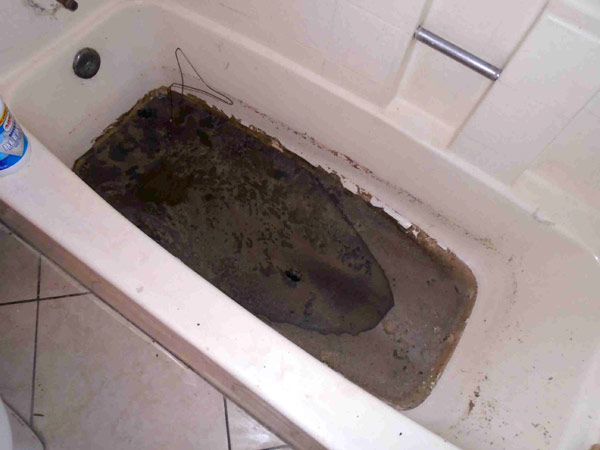Unpacking the Causes of Waste in the Bathtub
Unpacking the Causes of Waste in the Bathtub
Blog Article
Just about everyone will have his or her own perception about Why is Sewage Backing Up Into My Bathtub?.

Sewage backup in the tub can be a distressing and unsanitary problem for any kind of property owner. Not just is it troublesome, however it additionally poses significant health and wellness dangers and indicates underlying issues with the plumbing system. Understanding why sewer is turning up via the bath tub is critical for taking appropriate activity to address the issue effectively.
Introduction to the Issue
Typical Factors for Sewer Backup
Clogs in the Drain Line
One of one of the most typical root causes of sewage backup is a clog in the sewer line. This can take place as a result of the accumulation of debris, grease, or foreign objects in the pipelines, stopping appropriate circulation and triggering sewage to back up into your tub.
Tree Root Invasion
Tree origins seeking dampness and nutrients can penetrate sewer lines through little cracks or joints. Gradually, these origins can grow and broaden, creating substantial damages to the pipelines and resulting in sewage backup issues.
Comprehending the Issue
When sewer draws back up into the bath tub, it's a clear sign of a problem with the drainage system. The wastewater that should be streaming far from your home is rather finding its way back into your home, which can lead to significant damage and health hazards.
Possible Reasons
Several variables can add to sewer back-up in the tub. From obstructions in the sewage system line to issues with the plumbing framework, recognizing the origin is crucial for finding a remedy.
Aging Facilities
Older homes may have outdated plumbing systems that are extra prone to deterioration, fractures, and damage. As pipes age, they end up being much more vulnerable to leakages and obstructions, raising the likelihood of sewer backup occurrences.
Heavy Rainfall or Flooding
During durations of heavy rainfall or flooding, the drain system might become overloaded with excess water, creating backups and overflows. This can lead to sewage supporting right into bathtubs and other fixtures inside the home.
Indications of Sewage Back-up
Foul Odors
Undesirable smells rising from drains or components, particularly in the restroom, might suggest sewer backup problems. These smells are commonly solid and relentless, indicating a problem that requires prompt attention.
Slow Draining Fixtures
Tubs, sinks, and commodes that drain gradually or not whatsoever could be experiencing sewage back-up. If multiple fixtures are affected concurrently, it's likely that the problem stems from a common factor, such as the primary drain line.
Gurgling Noises
Weird gurgling or bubbling sounds originating from drains when water is running in other places in your house are indicative of air entraped in the plumbing system. This air accumulation can result from sewer backup and must be explored without delay.
Health Threats Connected With Sewage Back-up
Contamination of Water
Sewer backup can pollute the water in your home, posturing a severe health and wellness threat to you and your family. Exposure to contaminated water can bring about stomach concerns, skin infections, and other diseases.
Mold and mildew Growth
Moisture from sewage back-up can produce perfect problems for mold and mildew growth in your house. Mold spores can exacerbate respiratory system troubles and trigger allergies in delicate people, making prompt cleanup important.
Spread of Illness
Sewage contains dangerous bacteria, infections, and parasites that can trigger a range of illness, including hepatitis, cholera, and gastroenteritis. Entering into contact with sewage or infected surfaces puts you in danger of infection.
Tidying up After Sewage Back-up
Sanitation Procedures
Extensively disinfect and sterilize influenced areas after sewer backup to eliminate unsafe bacteria and stop mold and mildew development. Use appropriate cleansing products and safety equipment to ensure safe and efficient cleaning.
Restoration of Affected Locations
Fix any damages to floor covering, wall surfaces, or fixtures brought on by sewer backup. Relying on the level of the damage, you may require to change carpets, drywall, or other materials to restore your home to its pre-loss problem.
Immediate Actions to Take
Shutting Off Supply Of Water
In case of sewage backup, it's important to turn off the water supply to stop further contamination and damages. Find the main water shutoff valve in your house and shut it off till the concern can be dealt with.
Calling an Expert Plumber
Taking care of sewage backup is not a do it yourself job. Call an accredited plumber with experience in dealing with sewage-related concerns to assess the situation and do essential repair work or clean-ups.
Staying Clear Of Contact with Polluted Water
Up until the sewage backup is resolved, avoid contact with polluted water to prevent the spread of microorganisms and pathogens. Wear protective equipment if you have to remain in the afflicted location and wash your hands completely later.
Safety nets
Normal Maintenance of Sewage System Lines
Arrange routine inspections and upkeep of your drain lines to recognize and resolve potential issues before they escalate into major troubles. This can consist of clearing out particles, examining for tree origin breach, and fixing any damaged pipelines.
Installing Backwater Shutoffs
Consider installing bayou shutoffs in your plumbing system to prevent sewer from flowing back into your home during durations of heavy rainfall or flooding. These valves immediately close when water starts backing up, safeguarding your property from contamination.
Appropriate Disposal of Household Waste
Avoid purging anything besides toilet tissue and human waste down the bathroom to prevent obstructions and obstructions in the sewer line. Dispose of oil, oil, and other home chemicals correctly to decrease the danger of plumbing issues.
Why Is Water Backing Up in My Bathtub When I Flush My Toilet?
What to do about a sewer line clog
First, don’t bother with plunging. No amount of plunging will dislodge the clog in a sewer line. The clog is too far away. Plungers are for clogs in the toilet itself, not the sewer line. Plus, the most likely causes of a sewer clog are:
Tree roots Flushed toys or feminine products Grease buildup Those items don’t move easily. And in the case of tree roots, the roots need to be cut out of the pipe and the pipe will need to be repaired.
You’ll need a closet auger. A closet auger is a type of plumber’s snake with a protective cover to keep from scratching the delicate porcelain toilet. If the clog is further down, you may need to remove the toilet or use one of your cleanouts to get to the clog.
We also recommend doing a video inspection of the drain to ensure that the cause of the clog has been completely removed. Otherwise, you could have the same problem again in a few days or weeks.
https://mspplumbingheatingair.com/blog/why-is-water-backing-up-in-my-bathtub-when-i-flush-my-toilet

We were made aware of that write-up about Why sewage is coming up through your bathtub from a good friend on another site. I beg you set aside a second to share this blog posting if you appreciated it. We enjoy your readership.
Customer Reviews
Report this page